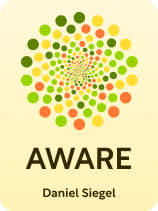

This article is an excerpt from the Shortform book guide to "Aware" by Daniel Siegel. Shortform has the world's best summaries and analyses of books you should be reading.
Like this article? Sign up for a free trial here.
How can you sharpen your focus and expand your awareness? What benefits might you experience from improving these skills?
In Aware, Dan Siegel encourages the practices of focused attention meditation and receptive attention meditation using the Wheel of Awareness. These techniques can help you live more fully in the present moment, experience life with greater richness, and gain a deeper understanding of yourself.
Read more to discover how to cultivate these practices and transform your daily life.
Developing Your Attention Skills
In his book, Siegel discusses two kinds of attention: receptive attention and focused attention. Meditation with the Wheel of Awareness—specifically practicing the first and second sections of the wheel—builds and strengthens both types of attention. This helps you expand your awareness and become fully aware of yourself, your surroundings, and others. You’ll then be able to live more in the present moment.
Focused attention: Focused attention is the process of directing your awareness consciously and intentionally to specific information inside yourself, such as thoughts and feelings, or in the external world, such as sights, sounds, and other sensory stimuli. Siegel says when you have well-developed focused attention, you can aim your awareness in one direction for a sustained period, ignore distractions, and bring your attention back to your object of focus when it wanders. The Wheel meditation develops focused attention by training you to use the wheel spoke to sustain focus on different sections of the wheel rim.
(Shortform note: The focus abilities Siegel identifies above reflect our capacity to consciously direct attention. He isn’t explicit about what cognitive processes allow for focused attention, but there are two accepted models in science that explain how it works. In both, your brain automatically detects certain features of stimuli, and if they’re important or relevant to you, they get “tagged” as something that needs your attention and deeper cognitive processing. Then, depending on the model, your brain either completely blocks unimportant stimuli or “turns down the volume” on them so that only important stimuli get through to further processing centers.)
According to Siegel, developing stronger focused attention can make living more engaging, rich, and enjoyable. This is because when you spend time focusing on what the sensations in your body are telling you, you can have a heightened experience with more clarity, depth, and detail.
(Shortform note: Siegel extols the virtues of focused attention, but in The Art of Thinking Clearly, Rolf Dobelli offers a counterargument. He posits that our capacity to narrow our focus might lead us to overlook crucial details. Dobelli contends that by zeroing in on specific elements, we risk dismissing or ignoring potentially relevant information in our surroundings. The “Invisible Gorilla” experiment vividly demonstrates this phenomenon: Participants tasked with focusing on particular aspects of a basketball game focused so intensely on those aspects that they largely failed to notice a person in a gorilla suit wandering across the court.)
Receptive attention: According to Siegel, receptive attention is an expansive state of awareness where you focus not just on one particular thing (be it the past, the future, or a specific task in front of you). Instead, you’re aware of your present-moment experiences without focusing on anything specific, and you notice and allow what you’re experiencing without trying to understand or change it.
(Shortform note: In Focus, Daniel Goleman agrees that receptive attention, what he calls open awareness, is a state of mind where your attention expands, and you are receptive to everything in the present moment. He also contends that open awareness includes a mental state called mind-wandering, where your attention wanders from one internal or external experience to another. He says that the mind-wandering aspect of receptive attention allows you to make creative breakthroughs, sort through personal concerns, ponder the past, and imagine the future. However, in contrast with Siegel, Goleman says a wandering mind can also take us out of the present moment, where we tend to make more errors and mistakes.)
Siegel says it’s important that you practice and strengthen your receptive attention skills because this state of attention creates the mental space for you to tell the difference between your awareness and the contents of your mind—thoughts, feelings, and sensations. He asserts that our mental experiences often feel deeply personal, leading us to strongly identify with them. This tendency to equate our inner mental content with our sense of self can be both automatic and compelling. However, when you can differentiate between the contents of your mind and your awareness, you can better understand that you’re more than your thoughts, feelings, and sensations. This realization can lead to feelings of greater equilibrium and freedom.
(Shortform note: Differentiating between the contents of your mind and your awareness, as Siegel explains the Wheel meditation can help you do, is called vipassana, or insight, meditation In Buddhism. In vipassana meditation, you mindfully observe your own mental processes to develop a detached awareness of your thoughts, feelings, and sensations. Essentially, you work to become an impartial observer of your own experience. This practice of “observing the observer” helps to create a separation between your awareness and the contents of your mind and encourages you to have a less rigid identification with your inner experiences, potentially leading to reduced suffering and a more expansive sense of self.)
The Wheel meditation develops receptive attention by developing your ability to differentiate between the hub, your awareness, and the contents of the rim—what you’re aware of. When you turn your attention to the hub of awareness itself, it can become a sanctuary of receptive attention, a calm and quiet space separate from the influx of sensations on the wheel’s rim. Siegel says you can feel more emotional balance when you recognize, through practice, when you’re entirely preoccupied with the rim and can return to the neutrality of the hub.
| The Wheel Meditation and Mindfulness-Based Stress Reduction The Wheel mediation practice of differentiating between your awareness and what you’re aware of is similar to core elements of an evidence-based approach to managing stress, improving mental health, and coping with chronic pain called Mindfulness-Based Stress Reduction (MBSR). MBSR practitioners often use concepts similar to the “hub and rim” metaphor of the Wheel meditation in their clinical settings. The approach articulates this idea through the lens of being mode versus doing mode: Doing mode is akin to being caught up in the rim of the wheel. In doing mode, your mind is occupied by goal-oriented thinking, problem-solving, and ruminating thoughts. This mode can be practically useful in life but can also lead to stress and overwhelm. Being mode is similar to resting in the hub of the wheel. When you’re in being mode, you have a direct, immediate, nonconceptual experience of the present moment. Feelings of acceptance and ease often accompany it. In MBSR programs, participants recognize when they’re stuck in doing mode and work to intentionally shift into being mode, similar to moving attention from the rim to the hub of the wheel. |

———End of Preview———
Like what you just read? Read the rest of the world's best book summary and analysis of Daniel Siegel's "Aware" at Shortform.
Here's what you'll find in our full Aware summary:
- The benefits of increasing your awareness of yourself and the world
- How to use a meditation tool called the Wheel of Awareness
- How the Wheel of Awareness improves your bodily functions






